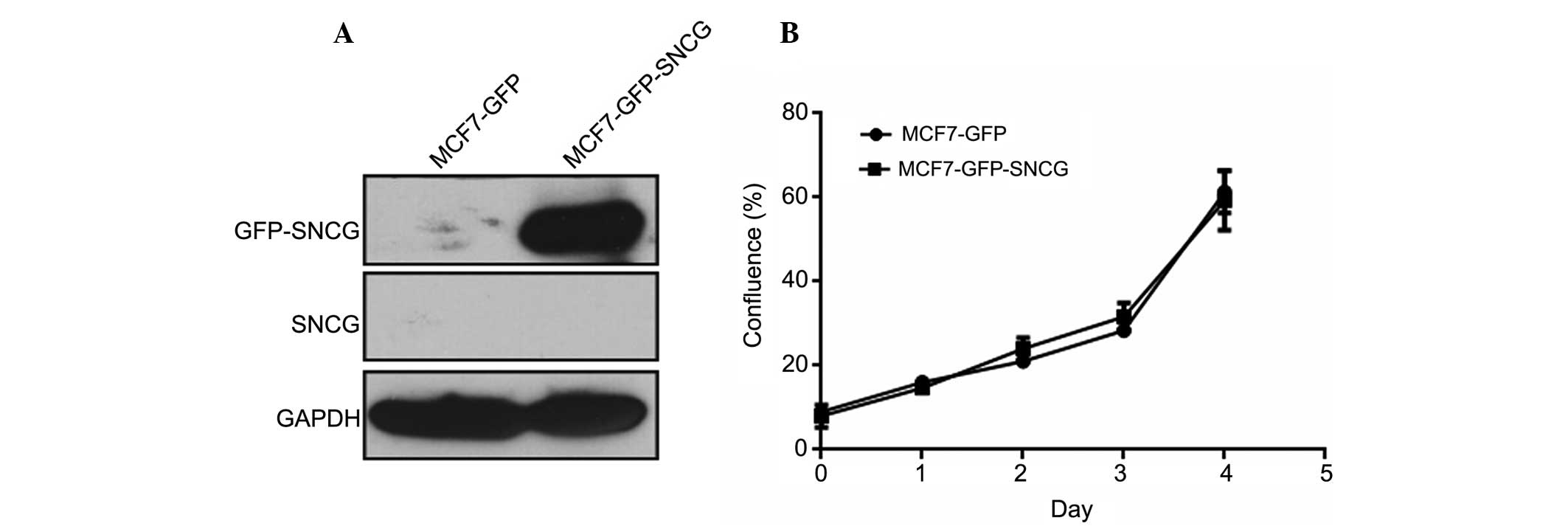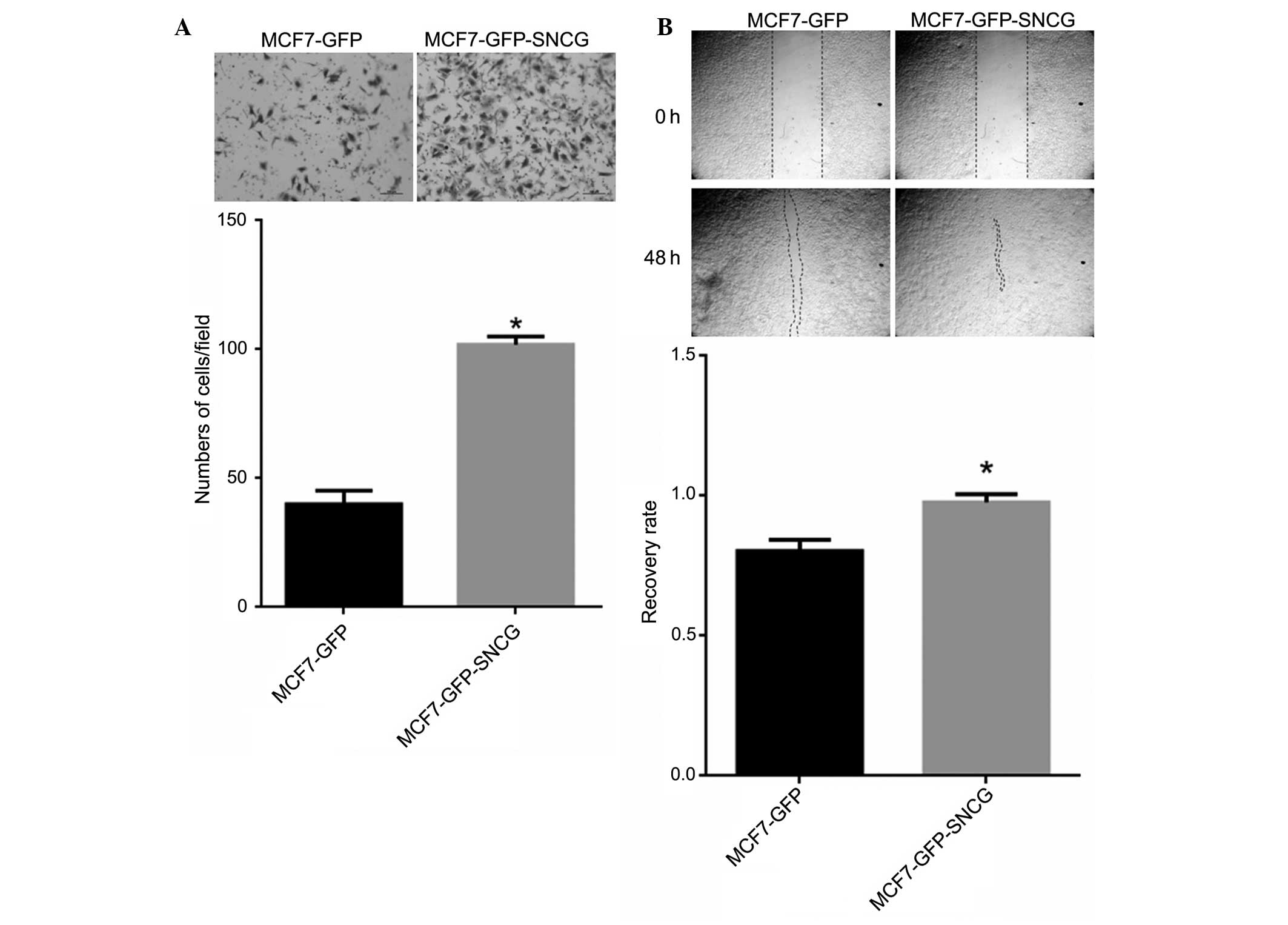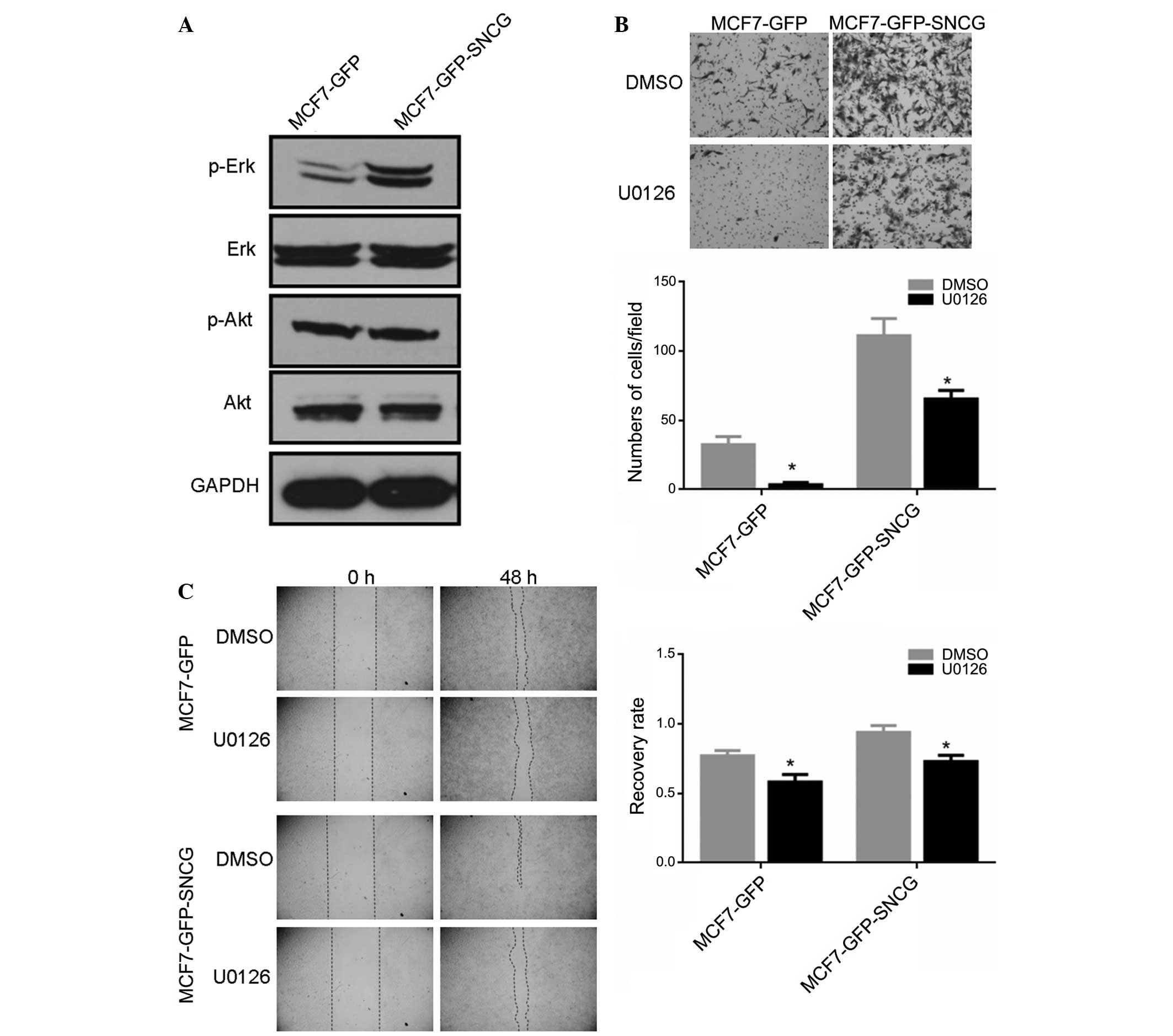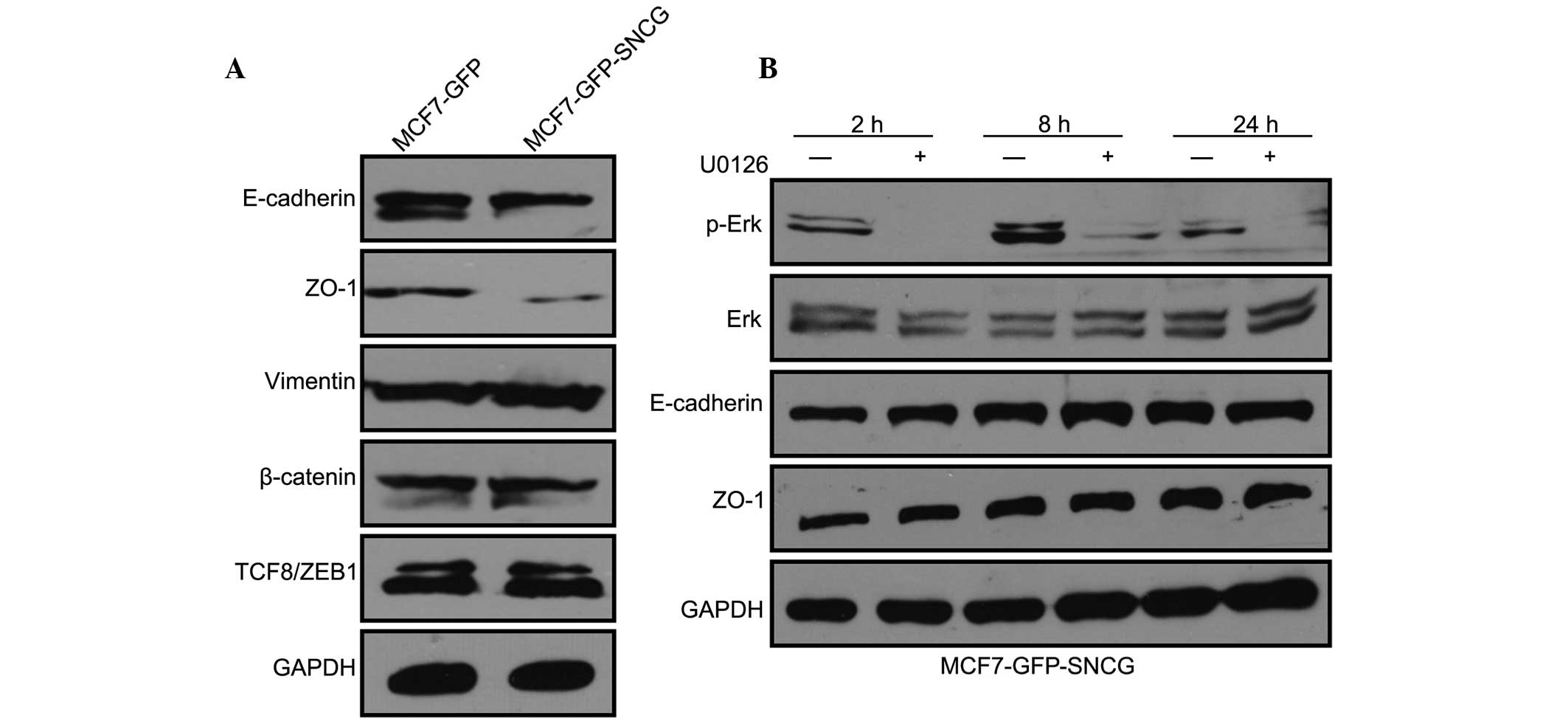Synuclein-γ promotes migration of MCF7 breast cancer cells by activating extracellular-signal regulated kinase pathway and breaking cell-cell junctions
- Authors:
- Published online on: May 19, 2015 https://doi.org/10.3892/mmr.2015.3799
- Pages: 3795-3800
Abstract
Introduction
The synuclein family consists of synuclein-α (SNCA), synuclein-β (SNCB) and synuclein-γ (SNCG). SNCA has been widely investigated due to its role in pathogenesis of neurodegenerative diseases, such as Alzheimer's disease and Parkinson's disease (1,2). SNCB assumes a neuroprotective role by inhibiting SNCA expression and aggregation (3,4). SNCG was initially termed breast cancer specific gene 1 on account of its high levels in advanced infiltrating breast carcinoma, compared with those in normal or benign breast lesions (5).
Elevated level of SNCG is detected in a wide range of cancer types, including gastric, lung, liver, colon, ovarian, cervical and esophageal cancer, and glioma (6–10). In addition, it correlates with adverse outcomes in breast cancer (11,12) and colon cancer (10). Downregulation of SNCG by small interfering (si)RNA decreased migration and invasion of HCT116 colorectal cancer cells (13). A moderate elevation of matrix metalloproteinase (MMP)2 and significant upregulation of MMP9 occurred in Y79 retinoblastoma cells overexpressing SNCG (14). SNCG was shown to promote migration of MDA-MB-435 breast cancer, and A2780 and OVCAR5 ovarian cancer cells by modulating RHO and Erk pathways. Inhibition of the RHO pathway by C. difficile Toxin B or of the Erk pathway by U0126 blocked cell migration in cells overexpressing SNCG (15). However, the exact mechanism of how SNCG promotes cell motility remains unclear.
A previous study showed that SNCA promoted the phos-phorylation of Akt (16). Since SNCA shares homologous sequences and similar functions with SNCG, it was proposed that there is a correlation between SNCG and the Akt pathway. Epithelial to mesenchymal transition (EMT), is currently the focus of cancer cell migration, invasion and metastasis investigation (17). During EMT, non-motile, polarized epithelial cells dissolve their cell-cell junctions and convert into individual, non-polarized, motile and invasive mesenchymal cells (17). Considering the role of SNCG in promoting cell invasiveness (13–15), it would be interesting to evaluate the correlation between SNCG and EMT. Based on the fact that EMT is prompted by various signaling pathways, including Erk (18) and Akt (19), while SNCG activated Erk pathway (15,20), we explored the possible connection between SNCG and EMT in this study.
Materials and methods
Materials and cell lines
The stable cell line MCF7-green fluorescent protein (GFP)-SNCG, which stably overex-presses GFP-SNCG, and the MCF7-GFP control cell line were constructed by respectively transfecting MCF7 cells (American Type Culture Collection, Manassas, VA, USA) with pEGFP-SNCG (kindly provided by Dr. Erich Shi; Albert Einstein College of Medicine, Bronx, NY, USA) and pEGFP-N1 (Promega Corporation, Madison, WI, USA). MCF7-GFP-SNCG and MCF7-GFP were cultured in RPMI-1640 medium supplemented with 10% fetal bovine serum (FBS) (all from Bioroc Pharmaceutical & Biotec Co., Ltd., Tianjin, China). Transwell chambers with 8 µm polycarbonate membranes in 24-well dishes were purchased from Corning Inc. (Corning, NY, USA). Anti-E-cadherin (cat. no. R868) was purchased from Bioworld (Nanjing, China). Anti-p-Erk (cat. no. 9101), anti-Erk (cat. no. 9107), anti-p-Akt (cat. no. 12694), anti-Akt (cat. no. 2920), anti-ZO-1 (cat. no. 8193), anti-Vimentin (cat. no. 3390), anti-β-catenin (cat. no. 2698) and anti-TCF8/ZEB1 (cat. no. 3396) antibodies, and U0126, a MEK inhibitor, were purchased from Cell Signaling Technology Inc. (Danvers, MA, USA).
Cell proliferation analysis
Cells were seeded in 96-well plates in triplicate with RPMI-1640 and 10% FBS. The confluence values were measured using the CloneSelect Imager system (Molecular Devices Ltd., New Milton, UK) at 0, 24, 48, 72 and 96 h. The confluence values were positively correlated with cell numbers. Experiments were repeated twice.
Cell migration assay
Cells (4×104) were suspended in serum-free RPMI-1640 and added to the upper chamber. RPMI-1640 (700 µl) with 10% FBS was added to the lower chamber at the same time. Chambers were incubated at 37°C in the 5% CO2 incubator for 24 h. Following incubation, the chambers were fixed with pre-cooled methanol for 30 min and stained with 0.1% crystal violet (Sigma-Aldrich, St. Louis, MO, USA) for 30 min. Non-migrated cells on the upper surface of filters were removed with cotton swabs. Cell numbers were counted in five random fields using light microscopy (Eclipse 80i; Nikon Corporation, Tokyo, Japan). Experiments were repeated twice.
Wound healing assay
Cells were grown to 95% confluency in a 24-well plate in RPMI-1640 medium with 10% FBS. A wound was created by scratching monolayer cells with a sterile 200 µl pipette tip. Cells were washed three times with phosphate-buffered saline to remove non-adherent cells. RPMI-1640 medium with 2% fetal bovine serum were added. Images of the wound were captured at different time points. The recovery rate of the wound was measured and quantified using Image Pro Plus version 7.0 software (Media Cybernetics, Warrendale, PA, USA) and calculated using the equation: % Cell migration = [1-(scratch area at Tx)/scratch area at T0]. Where the Tx is the respective time point and T0 is the time after the scratch. Experiments were repeated twice.
Western blot analysis
For western blot analysis, cells were harvested with 2X sodium dodecyl sulfate and boiled for 10 min, then loaded on 12% polyacrylamide gels. After electrophoresis, proteins were transferred onto a nitrocellulose membrane (Bio-Rad Laboratories, Inc., Hercules, CA, USA), blocked for 2 h in 5% skimmed milk. Subsequently, membranes were probed with primary antibodies diluted in 5% bovine serum albumin (Sigma-Aldrich) overnight at 4°C, followed by incubation with secondary antibodies for 45 min at room temperature. The enhanced chemiluminesence system (Pierce Biotechnology, Inc., Rockford, IL, USA) was used for analysis. GAPDH was used as a loading control.
Statistical analysis
SPSS software, version 17.0 (SPSS Inc., Chicago, IL, USA) was used for statistical analysis. The two-sided t-test method was used for analyzing the difference between the experimental group and the control group. P<0.05 was considered to indicate a statistically significant difference.
Results
SNCG has no effect on the proliferation of MCF7 breast cancer cells
To investigate the function of SNCG, MCF7-GFP-SNCG breast cancer cells and MCF7-GFP control cells were selected for the study. As detected by SNCG monoclonal antibodies, which weres prepared by our lab in a previous study (21), endogenous SNCG was undetectable in MCF7-GFP-SNCG and MCF7-GFP cells, while the fusion protein GFP-SNCG was strongly expressed in MCF7-GFP-SNCG cells (Fig. 1A). In the proliferation assay, no significant difference between MCF7-GFP-SNCG and MCF7-GFP cells was found (P=0.711), suggesting that SNCG has a minimal effect on the proliferation of MCF7 breast cancer cells (Fig. 1B).
SNCG increases the migration of MCF7 breast cancer cells in vitro
To investigate whether SNCG promoted migration of MCF7 cells, Transwell and wound healing assays were performed. In the Transwell assay, the number of migrated MCF7-GFP-SNCG cells was almost twice that of MCF7-GFP, and the difference between them was statistically significant (P<0.05, Fig. 2A). In addition, MCF7-GFP-SNCG cells also migrated faster than MCF7-GFP cells in the wound healing assay (Fig. 2B). Therefore, SNCG significantly promoted the mobility of MCF7 breast cancer cells.
Erk pathway mediates SNCG-promoted migration
SNCG had been demonstrated to be associated with Erk and constitutively activated Erk (15,20). The Akt pathway was also shown to be activated by SNCA (16). Considering that Erk and Akt pathways have essential roles in regulating pathways related to cancer malignant phenotypes, it was hypothesized that SNCG may enhance the mobility of MCF7 cells via Erk or Akt pathways. To test this hypothesis, western blotting was performed to detect the expression of p-Erk and p-Akt. As shown in Fig. 3A, SNCG upregulated p-Erk and had no effect on p-Akt, which indicated SNCG activated the Erk pathway rather than the Akt pathway in MCF7 cells. To further investigate whether the Erk pathway contributes to SNCG-induced mobility in MCF7 cells, U0126, a MEK inhibitor, was used. Cells were cultured in 10 µM U0126 1 h prior to performing Transwell and wound healing assays. The results revealed that U0126 significantly reduced migration and healing of MCF7-GFP-SNCG and MCF7-GFP cells (P<0.05, Fig. 3B and C). Therefore, SNCG promoted migration of MCF7 by activating downstream Erk pathway.
SNCG promotes migration by breaking cell adherens junctions and tight junctions, which is not triggered by the Erk pathway
EMT is key in cancer cell metastasis, and is regulated by various pathways, including Erk and Akt (18,19). According to the fact that SNCG may promote cancer cell migration by activating the Erk pathway, the correlation between SNCG and EMT was then examined. To identify whether SNCG had an impact on EMT, western blotting was conducted to check the relevant protein expression levels in MCF7-GFP-SNCG and MCF7-GFP cells. The data revealed that SNCG downregulated EMT-related proteins, such as E-cadherin and ZO-1 (Fig. 4A). E-cadherin is the major component of epithelial adherens junctions (22), while ZO-1 is important in cell tight junctions (23). Thus, the results implied that SNCG may promote the migration of MCF7 by breaking cell adherens junctions and tight junctions. Certain studies reported that Erk pathway could induce EMT (18). However, although it was demonstrated that U0126 did block the Erk pathway, the expression levels of E-cadherin and ZO-1 were not changed (Fig. 4B), implying that SNCG-activated Erk had no effect on E-cadherin or ZO-1 in MCF7 cells.
Discussion
SNCG shares the conserved N-terminal domain with SNGA and SNGB, and the homologous identities are 54 and 56%, respectively. Their main differences are in their acidic C-terminal domain, which is presumably where their functional differences arise (24). Various studies have shown that SNCG promoted migration, invasion and metastasis of cancer cells (13–15,25), and SNCG was associated with recurrence and poor prognosis of multiple types of cancer. Our previous results also indicated that SNCG is an independent predictor for poor prognosis in patients with breast cancer and colon adenocarcinoma (8,11).
In order to evaluate the function of SNCG on cancer cells, a stable MCF7-GFP-SNCG cell line overexpressing SNCG and MCF7-GFP controls were constructed. A proliferation assay was conducted and determined that SNCG had no effect on the proliferative ability of MCF7 cells, which was in accordance with the results of a previous study (26), but was contradictory to the results of others (13,27). It was speculated that these differences were due to the different type of cells used for experiments. Transwell and wound healing assays were also performed to test the effect of SNCG on migration. The results revealed that SNCG accelerated migration of MCF7 breast cancer cells, which coincided with the results of numerous studies (13,15,28). Taking the results of the proliferation assay into consideration, the significant difference in the migration experiment was not caused by the difference in proliferation. Thus, SNCG indeed promoted the motility of MCF7 cells.
Next, the mechanism of how SNCG promote motility of MCF7 cells was explored. It was found that SNCG activated the Erk pathway but not the Akt pathway, suggesting that SNCG has functional difference with its homologous proteins. Furthermore, it was demonstrated that U0126 blocked migration of MCF7-GFP-SNCG and MCF7-GFP cells, which further identified the role of the Erk pathway in enhancing the motility of MCF7 cells. Recently, several studies have shown that EMT is involved in the development and progression of cancer (17,29). EMT is an essential way for cancer cells to gain migratory and invasive properties (29). The correlation between SNCG and EMT has not been reported previously. According to the fact that SNCG modulated the Erk pathway and the Erk pathway promotes EMT (18), this correlation was explored. Western blotting was performed to detect the expression levels of EMT-associated proteins, such as E-cadherin, ZO-1 and Vimentin. It was demonstrated that SNCG down-regulated E-cadherin and ZO-1, while had no impact on other EMT-related proteins, such as Vimentin, β-catenin or TCF8/ZEB1. E-cadherin and ZO-1 are all essential factors in cell adherens junctions and tight junctions. The results indicated that SNCG may break these junctions. Considering that EMT could be modulated by the Erk pathway, it was assumed that SNCG may downregulate the expression level of E-cadherin and ZO-1 by activating the Erk pathway. U0126 was used again to confirm this hypothesis; however, the results indicated that the expression levels of E-cadherin and ZO-1 were not regulated by Erk pathway. Due to the complex signaling pathways existing in the cells, it was assumed that SNCG utilizes other pathways to downregulate E-cadherin and ZO-1, which requires further investigation in the future.
In conclusion, overexpression of SNCG promoted migration of MCF7 breast cancer cells; however, had no effect on proliferation. The data also demonstrated that SNCG promoted migration by upregulating the Erk pathway and downregulating E-cadherin and ZO-1 in manner independent of Erk. The results provided novel evidence of a correlation between SNCG and cancer, and confirmed the association between SNCG and the EMT-associated proteins E-cadherin and ZO-1, thus highlighting the effects of SNCG on the malignant phenotype of cancer cells.
Acknowledgments
This study was supported by the National Natural Science Foundation of China (grant no. 81272410) and National 973 Program (grant no. 2015CB553906).
References
|
Ueda K, Fukushima H, Masliah E, et al: Molecular cloning of cDNA encoding an unrecognized component of amyloid in alzheimer disease. Proc Natl Acad Sci USA. 90:11282–11286. 1993. View Article : Google Scholar : PubMed/NCBI | |
|
Spillantini MG, Schmidt ML, Lee VM, et al: Alpha-synuclein in lewy bodies. Nature. 388:839–840. 1997. View Article : Google Scholar : PubMed/NCBI | |
|
Hashimoto M, Rockenstein E, Mante M, et al: Beta-synuclein inhibits alpha-synuclein aggregation: a possible role as an anti-parkinsonian factor. Neuron. 32:213–223. 2001. View Article : Google Scholar : PubMed/NCBI | |
|
Park JY and Lansbury PT: Beta-synuclein inhibits formation of alpha-synuclein protofibrils: a possible therapeutic strategy against Parkinson's disease. Biochemistry. 42:3696–3700. 2003. View Article : Google Scholar : PubMed/NCBI | |
|
Ji HJ, Liu YE, Jia T, et al: Identification of a breast cancer specific gene, BCSG1, by direct differential cDNA sequencing. Cancer Res. 57:759–764. 1997.PubMed/NCBI | |
|
Guo J, Shou C, Meng L, et al: Neuronal protein synuclein-γ predicts poor clinical outcome in breast cancer. Int J Cancer. 121:1296–1305. 2007. View Article : Google Scholar : PubMed/NCBI | |
|
Bruening W, Giasson BI, Klein-Szanto AJ, et al: Synucleins are expressed in the majority of breast and ovarian carcinomas and in preneoplastic lesions of the ovary. Cancer. 88:2154–2163. 2000. View Article : Google Scholar : PubMed/NCBI | |
|
Liu H, Liu W, Wu Y, et al: Loss of epigenetic control of synu-clein-gamma gene as a molecular indicator of metastasis in a wide range of human cancers. Cancer Res. 65:7635–7643. 2005.PubMed/NCBI | |
|
Iwaki H, Kageyama S, Isono T, et al: Diagnostic potential in bladder cancer of a panel of tumor markers (calreticulin, gamma-synuclein and catechol-o-methyltransferase) identified by proteomic analysis. Cancer Sci. 95:955–961. 2004. View Article : Google Scholar : PubMed/NCBI | |
|
Liu C, Dong B, Lu AP, et al: Synuclein gamma predicts poor clinical outcome in colon cancer with normal levels of carcino-embryonic antigen. BMC Cancer. 10:3592010. View Article : Google Scholar | |
|
Guo J, Shou C, Meng L, et al: Neuronal protein synuclein-γ predicts poor clinical outcome in breast cancer. Int J Cancer. 121:1296–1305. 2007. View Article : Google Scholar : PubMed/NCBI | |
|
Wu K, Quan Z, Weng Z, et al: Expression of neuronal protein synuclein gamma gene as a novel marker for breast cancer prognosis. Breast Cancer Res Treat. 101:259–267. 2007. View Article : Google Scholar | |
|
Ye Q, Feng B, Peng YF, et al: Expression of γ-synuclein in colorectal cancer tissues and its role on colorectal cancer cell line HCT116. World J Gastroenterol. 15:5035–5043. 2009. View Article : Google Scholar : PubMed/NCBI | |
|
Surgucheva IG, Sivak JM, Surguchov AP, et al: Effect of gamma-synuclein overexpression on matrix metalloproteinases in retinoblastoma Y79 cells. Arch Biochem Biophys. 410:167–176. 2003. View Article : Google Scholar : PubMed/NCBI | |
|
Pan ZZ, Bruening W and Godwin AK: Involvement of RHO GTPases and ERK in synuclein-gamma enhanced cancer cell motility. Int J Oncol. 29:289–295. 2006. | |
|
Seo JH, Rah JC, Choi SH, et al: Alpha-synuclein regulates neuronal survival via Bcl-2 family expression and PI3/Akt kinase pathway. FASEB J. 16:1826–1828. 2002.PubMed/NCBI | |
|
Grunert S, Jechlinger M and Beug H: Diverse cellular and molecular mechanisms contribute to epithelial plasticity and metastasis. Nat Rev Mol Cell Biol. 4:657–665. 2003. View Article : Google Scholar : PubMed/NCBI | |
|
Xie L, Law BK, Chytil AM, Brown KA, Aakre ME and Moses HL: Activation of the Erk pathway is required for TGF-β1-induced EMT in vitro. Neoplasia. 6:603–610. 2004. View Article : Google Scholar : PubMed/NCBI | |
|
Wang H, Wang HS, Zhou BH, et al: Epithelial-mesenchymal transition (EMT) induced by TNF-α requires AKT/GSK-3β-mediated stabilization of snail in colorectal cancer. PLoS One. 8:e566642013. View Article : Google Scholar | |
|
Pan ZZ, Bruening W, Godwin AK, et al: Gamma-synuclein promotes cancer cell survival and inhibits stress- and chemotherapy drug-induced apoptosis by modulating MAPK pathways. J Biol Chem. 277:35050–35060. 2002. View Article : Google Scholar : PubMed/NCBI | |
|
Liu C, Guo J, Qu L, et al: Applications of novel monoclonal antibodies specific for synuclein-gamma in evaluating its levels in sera and cancer tissues from colorectal cancer patients. Cancer Lett. 269:148–158. 2008. View Article : Google Scholar : PubMed/NCBI | |
|
Cavallaro U and Christofori G: Cell adhesion and signaling by cadherins and Ig-CAMs in cancer. Nat Rev Cancer. 4:118–132. 2004. View Article : Google Scholar : PubMed/NCBI | |
|
Elizabeth M, Christopher TC and Ian GM: Zonula occludens-a function in the assembly of tight junctions in Madin-Darby canine kidney epithelial cells. Mol Biol Cell. 17:1922–1932. 2006. View Article : Google Scholar | |
|
Surguchov A: Molecular and cellular biology of synucleins. Int Rev Cell Mol Biol. 270:225–317. 2008. View Article : Google Scholar : PubMed/NCBI | |
|
Ye Q, Huang F, Wang XY, et al: Effects of γ-synuclein on the tumorigenicity and metastasis of colon cancer SW116 cells in vitro and in vivo. Oncol Rep. 30:2161–2170. 2013.PubMed/NCBI | |
|
Jiang Y, Liu YE, Lu A, et al: Stimulation of estrogen receptor signaling by γ-synuclein. Cancer Res. 63:3899–3903. 2003.PubMed/NCBI | |
|
Chen JY, Jiao L, Xu CL, et al: Neural protein gamma-synuclein interacting with androgen receptor promotes human prostate cancer progression. BMC Cancer. 12:5932012. View Article : Google Scholar : PubMed/NCBI | |
|
Jia T, Liu YE, Liu J and Shi YE: Stimulation of breast cancer invasion and metastasis by synuclein γ. Cancer Res. 59:742–747. 1999.PubMed/NCBI | |
|
Yilmaz M and Christofori G: EMT, the cytoskeleton and cancer cell invasion. Cancer Metastasis Rev. 28:15–33. 2009. View Article : Google Scholar : PubMed/NCBI |













